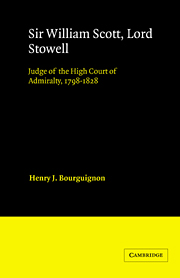Book contents
- Frontmatter
- Contents
- Preface
- List of abbreviations
- 1 Survey of English admiralty jurisdiction: how did it vanish?
- 2 Sir William Scott – a biographical sketch
- 3 The law of the instance court
- 4 Prize law: nationality – a study in detail
- 5 Prize law – a survey
- 6 Scott's judicial philosophy
- 7 Scott's influence
- Appendix: the Stowell notebooks
- Bibliography of primary sources
- Index
- CAMBRIDGE STUDIES IN ENGLISH LEGAL HISTORY
2 - Sir William Scott – a biographical sketch
Published online by Cambridge University Press: 29 October 2009
- Frontmatter
- Contents
- Preface
- List of abbreviations
- 1 Survey of English admiralty jurisdiction: how did it vanish?
- 2 Sir William Scott – a biographical sketch
- 3 The law of the instance court
- 4 Prize law: nationality – a study in detail
- 5 Prize law – a survey
- 6 Scott's judicial philosophy
- 7 Scott's influence
- Appendix: the Stowell notebooks
- Bibliography of primary sources
- Index
- CAMBRIDGE STUDIES IN ENGLISH LEGAL HISTORY
Summary
William Scott was born on October 17, 1745 at his grandfather's country house at Heworth, three miles from Newcastle-upon-Tyne, but on the Durham side of the Tyne. His birth in Durham county, rather than in Newcastle where his parents' home was, resulted from the alarm in Newcastle at the advance of the Jacobite rebels. His mother shortly before the birth had left Newcastle, where the residents felt threatened, to the greater safety of Heworth. Mrs Scott gave birth to twins, William, the eldest son, and Barbara.
Scott's father, William Scott of Newcastle was a coal-fitter, a trade which had occupied not only his father's family for at least two generations, but his mother's family also. Coal-fitters were middlemen between the producers of coal in the Tyne region and the ship owners who carried it to London. During the seventeenth century, many colliery owners had ceased dealing directly with the ship owners and instead negotiated with the fitters who bought through contracts with the mine owners for delivery at the piers. The fitter then found a shipmaster to purchase his coal, had it loaded in keels or coal barges for delivery aboard the ships, arranged for clearance of the coal and paid the taxes. Fitters often were interested in the mining business either as partners in the collieries or indirectly as money lenders or owners of royalties. Fitters, as middlemen, used their power of playing off one mine owner against another to buy coal at the lowest price and by close combination with other fitters forced up the price of the coal they sold to the shippers.
- Type
- Chapter
- Information
- Sir William Scott, Lord StowellJudge of the High Court of Admiralty, 1798–1828, pp. 31 - 58Publisher: Cambridge University PressPrint publication year: 1987
- 1
- Cited by



